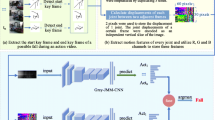Abstract
In this paper we aim for the replication of a state of the art architecture for recognition of human actions using skeleton poses obtained from a depth sensor. We review the usefulness of accurate human action recognition in the field of robotic elderly care, focusing on fall detection. We attempt fall recognition using a chained Growing When Required neural gas classifier that is fed only skeleton joints data. We test this architecture against Recurrent SOMs (RSOMs) to classify the TST Fall detection database ver. 2, a specialised dataset for fall sequences. We also introduce a simplified mathematical model of falls for easier and faster bench-testing of classification algorithms for fall detection.
The outcome of classifying falls from our mathematical model was successful with an accuracy of \( 97.12 \pm 1.65\,\%\) and from the TST Fall detection database ver. 2 with an accuracy of \(90.2 \pm 2.68\,\%\) when a filter was added.
Access this chapter
Tax calculation will be finalised at checkout
Purchases are for personal use only
Similar content being viewed by others
References
Arlot, S., Celisse, A.: A survey of cross-validation procedures for model selection. Stat. Surv. 4, 40–79 (2010). doi:10.1214/09-SS054
Burman, P.: A comparative study of ordinary cross-validation, v-fold cross-validation and the repeated learning-testing methods. Biometrika 76(3), 503–514 (1989)
Chan, M., Estéve, D., Escriba, C., Campo, E.: A review of smart homes-present state and future challenges. Comput. Methods Prog. Biomed. 91, 55–81 (2008). doi:10.1016/j.cmpb.2008.02.001
Fernandez-Granero, M.A., Sanchez-Morillo, D., Leon-Jimenez, A.: Computerised analysis of telemonitored respiratory sounds for predicting acute exacerbations of copd. Sensors (Basel) 15, 26978–26996 (2015). doi:10.3390/s151026978
Flodgren, G., Rachas, A., Farmer, A.J., Inzitari, M., Shepperd, S.: Interactive telemedicine: effects on professional practice and health care outcomes. In: Cochrane Database of Systematic Reviews. Wiley (2015)
Furao, S., Hasegawa, O.: An incremental network for on-line unsupervised classification and topology learning. Neural Netw. 19, 90–106 (2006). doi:10.1016/j.neunet.2005.04.006
Gasparrini, S., Cippitelli, E., Gambi, E., Spinsante, S., Wåhslén, J., Orhan, I., Lindh, T.: Proposal and experimental evaluation of fall detection solution basedon wearable and depth data fusion. In: Loshkovska, S., Koceski, S. (eds.) ICTInnovations 2015, Advances in Intelligent Systems and Computing, pp. 99–108. Springer International Publishing, Switzerland (2016)
Ho, T.-W., Huang, C.-T., Chiu, H.-C., Ruan, S.-Y., Tsai, Y.-J., Yu, C.-J., Lai, F.: Effectiveness of telemonitoring in patients with chronic obstructive pulmonary disease in Taiwan-a randomized controlled Trial. Sci. Rep. 6 (2016). doi:10.1038/srep23797
Jauch, E.C., Saver, J.L., Demaerschalk, B.M., Khatri, P., McMullan Jr., P.W., Qureshi, A.I., Rosenfield, K., Scott, P.A., Summers, D.R., Wang, D.Z.: AHA/ASA Guideline. Stroke (2013)
JointType enumeration [WWW Document], n.d. https://msdn.microsoft.com/en-us/library/microsoft.kinect.jointtype.aspx. Accessed 14 May 16
Koppula, H.S., Saxena, A.: Anticipating human activities using object affordances for reactive robotic response. IEEE Trans. Pattern Anal. Mach. Intell. 38, 14–29 (2016)
Martinetz, T.M., Schulten, K.J.: A “Neural Gas” networklearns topologies. In: Kohonen, T., Mäkisara, K., Simula, O., Kangas, J. (eds.) Proceedings of the International Conference on Artificial Neural Networks 1991, Espoo, Finland, pp. 397–402, Amsterdam, North-Holland, New York (1991)
Marsland, S., Shapiro, J., Nehmzow, U.: A self-organising network that grows when required. Neural Netw. 15, 1041–1058 (2002)
Parisi, G., Wermter, S., others.: Hierarchical SOM-based detection of novel behavior for 3D human tracking. In: The 2013 International Joint Conference on Neural Networks (IJCNN), pp. 1–8. IEEE (2011)
Parisi, G.I., Weber, C., Wermter, S.: Self-organizing neural integration of pose-motion features for human action recognition. Front. Neurorobotics 9, (2015). doi:10.3389/fnbot.2015.00003
Peacock, T., Hadjiconstantinou, N.: Course materials for 2.003J/1.053J dynamics and control I, Spring (2007). MIT OpenCourseWare (http://ocw.mit.edu), Massachusetts Institute of Technology. Accessed 13 May 2016
Prime sensor\(^{\text{TM}}\) NITE 1.3 framework programmer’s guide - NITE.pdf. http://pr.cs.cornell.edu/humanactivities/data/NITE.pdf. Accessed 14 May 2016
Rabbitt, S.M., Kazdin, A.E., Scassellati, B.: Applications and recommendations for expanded use. Clin. Psychol. Rev. 35, 35–46. doi:10.1016/j.cpr.2014.07.001
Valenzuela, T.D., Roe, D.J., Cretin, S., Spaite, D.W., Larsen, M.P.: Estimating effectiveness of cardiac arrest interventions: a logistic regression survival model. Circulation 96, 3308–3313 (1997). doi:10.1161/01.CIR.96.10.3308
Wilkinson, T.M.A., Donaldson, G.C., Hurst, J.R., Seemungal, T.A.R., Wedzicha, J.A.: Early therapy improves outcomes of exacerbations of chronic obstructive pulmonary disease. Am. J. Respir. Crit. Care Med. 169, 1298–1303 (2004). doi:10.1164/rccm.200310-1443OC
Yongli, G., Yin, O.S., Han, P.Y.: State of the art: a study on fall detection. World Acad. Sci. Eng. Technol. 62, 294–298 (2012)
Acknowledgment
This work was partially supported by CNPq Brazil (scholarship 232590/2014-1) and by SGS grant No. 10/279/OHK3/3T/13, sponsored by the CTU in Prague, Czech Republic.
Author information
Authors and Affiliations
Corresponding author
Editor information
Editors and Affiliations
Rights and permissions
Copyright information
© 2016 Springer International Publishing AG
About this paper
Cite this paper
Klein, F.B., Štěpánová, K., Cangelosi, A. (2016). Implementation of a Modular Growing When Required Neural Gas Architecture for Recognition of Falls. In: Hirose, A., Ozawa, S., Doya, K., Ikeda, K., Lee, M., Liu, D. (eds) Neural Information Processing. ICONIP 2016. Lecture Notes in Computer Science(), vol 9947. Springer, Cham. https://doi.org/10.1007/978-3-319-46687-3_58
Download citation
DOI: https://doi.org/10.1007/978-3-319-46687-3_58
Published:
Publisher Name: Springer, Cham
Print ISBN: 978-3-319-46686-6
Online ISBN: 978-3-319-46687-3
eBook Packages: Computer ScienceComputer Science (R0)




